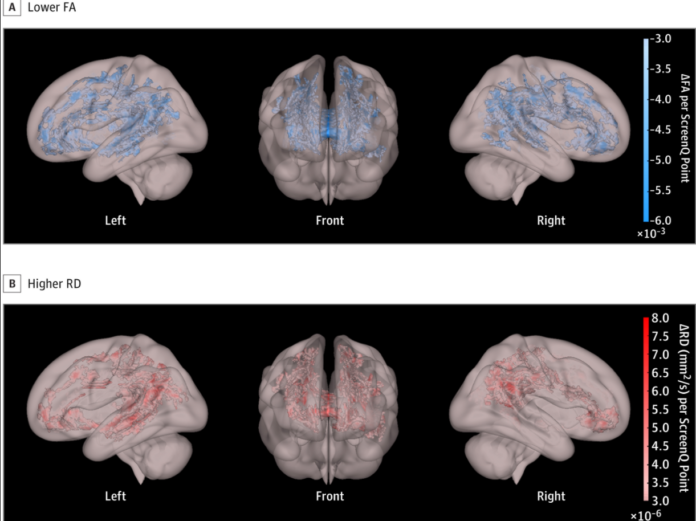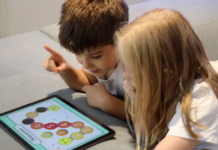John S. Hutton, MS, MD1,2; Jonathan Dudley, PhD2,3; Tzipi Horowitz-Kraus, PhD1,2,3,4; Tom DeWitt, MD1,2; Scott K. Holland, PhD2,3,5
Published in Jama Pediatrics Journal
November 4, 2019
Question Is screen-based media use associated with differences in the structural integrity of brain white matter tracts that support language and literacy skills in preschool-aged children?
Findings In this cross-sectional study of 47 healthy prekindergarten children, screen use greater than that recommended by the American Academy of Pediatrics guidelines was associated with (1) lower measures of microstructural organization and myelination of brain white matter tracts that support language and emergent literacy skills and (2) corresponding cognitive assessments.
Meaning These findings suggest a need for further study into the association between screen-based media use and the developing brain, particularly during early childhood.Abstract
Importance The American Academy of Pediatrics (AAP) recommends limits on screen-based media use, citing its cognitive-behavioral risks. Screen use by young children is prevalent and increasing, although its implications for brain development are unknown.
Objective To explore the associations between screen-based media use and integrity of brain white matter tracts supporting language and literacy skills in preschool-aged children.
Design, Setting, and Participants This cross-sectional study of healthy children aged 3 to 5 years (n = 47) was conducted from August 2017 to November 2018. Participants were recruited at a US children’s hospital and community primary care clinics.
Exposures Children completed cognitive testing followed by diffusion tensor imaging (DTI), and their parent completed a ScreenQ survey.
Main Outcomes and Measures ScreenQ is a 15-item measure of screen-based media use reflecting the domains in the AAP recommendations: access to screens, frequency of use, content viewed, and coviewing. Higher scores reflect greater use. ScreenQ scores were applied as the independent variable in 3 multiple linear regression models, with scores in 3 standardized assessments as the dependent variable, controlling for child age and household income: Comprehensive Test of Phonological Processing, Second Edition (CTOPP-2; Rapid Object Naming subtest); Expressive Vocabulary Test, Second Edition (EVT-2; expressive language); and Get Ready to Read! (GRTR; emergent literacy skills). The DTI measures included fractional anisotropy (FA) and radial diffusivity (RD), which estimated microstructural organization and myelination of white matter tracts. ScreenQ was applied as a factor associated with FA and RD in whole-brain regression analyses, which were then narrowed to 3 left-sided tracts supporting language and emergent literacy abilities.
Results Of the 69 children recruited, 47 (among whom 27 [57%] were girls, and the mean [SD] age was 54.3 [7.5] months) completed DTI. Mean (SD; range) ScreenQ score was 8.6 (4.8; 1-19) points. Mean (SD; range) CTOPP-2 score was 9.4 (3.3; 2-15) points, EVT-2 score was 113.1 (16.6; 88-144) points, and GRTR score was 19.0 (5.9; 5-25) points. ScreenQ scores were negatively correlated with EVT-2 (F2,43 = 5.14; R2 = 0.19; P < .01), CTOPP-2 (F2,35 = 6.64; R2 = 0.28; P < .01), and GRTR (F2,44 = 17.08; R2 = 0.44; P < .01) scores, controlling for child age. Higher ScreenQ scores were correlated with lower FA and higher RD in tracts involved with language, executive function, and emergent literacy abilities (P < .05, familywise error–corrected), controlling for child age and household income.
Conclusions and Relevance This study found an association between increased screen-based media use, compared with the AAP guidelines, and lower microstructural integrity of brain white matter tracts supporting language and emergent literacy skills in prekindergarten children. The findings suggest further study is needed, particularly during the rapid early stages of brain development.
Source:https://jamanetwork.com/journals/jamapediatrics/article-abstract/2754101?guestAccessKey=56c4b22b-ee5f-4594-bb23-c3813c9cccb1&utm_source=For_The_Media&utm_medium=referral&utm_campaign=ftm_links&utm_content=tfl&utm_term=110419
Comment: Interestingly, there is physical evidence in the parts of the brain that account for language and literary skills when children have too much screen time. In other articles, delayed speech is commonly noticed in children who spend a lot of time on devices. This article is important because it further emphasizes that screen time affects children and is a problem that needs to be addressed.




